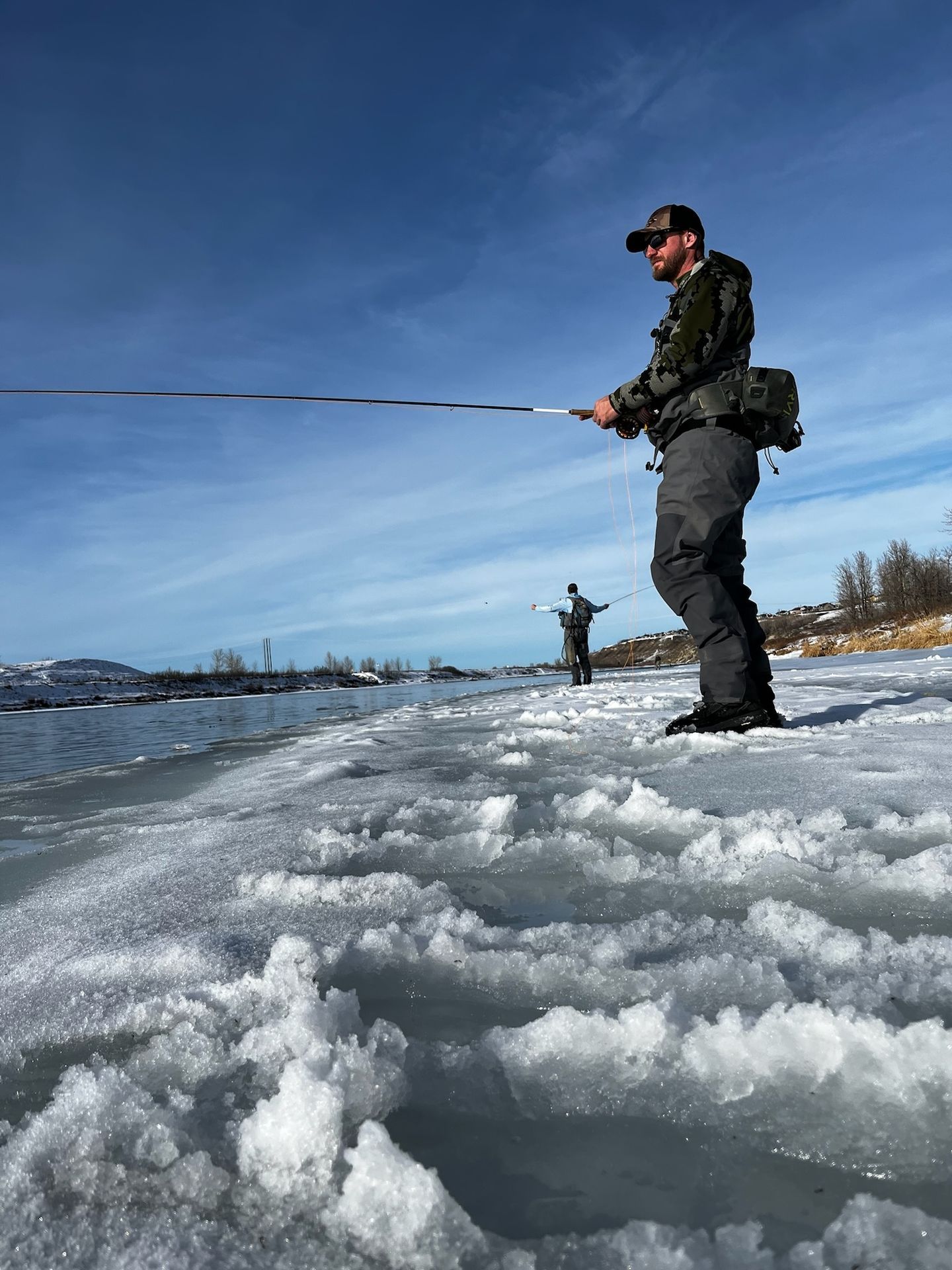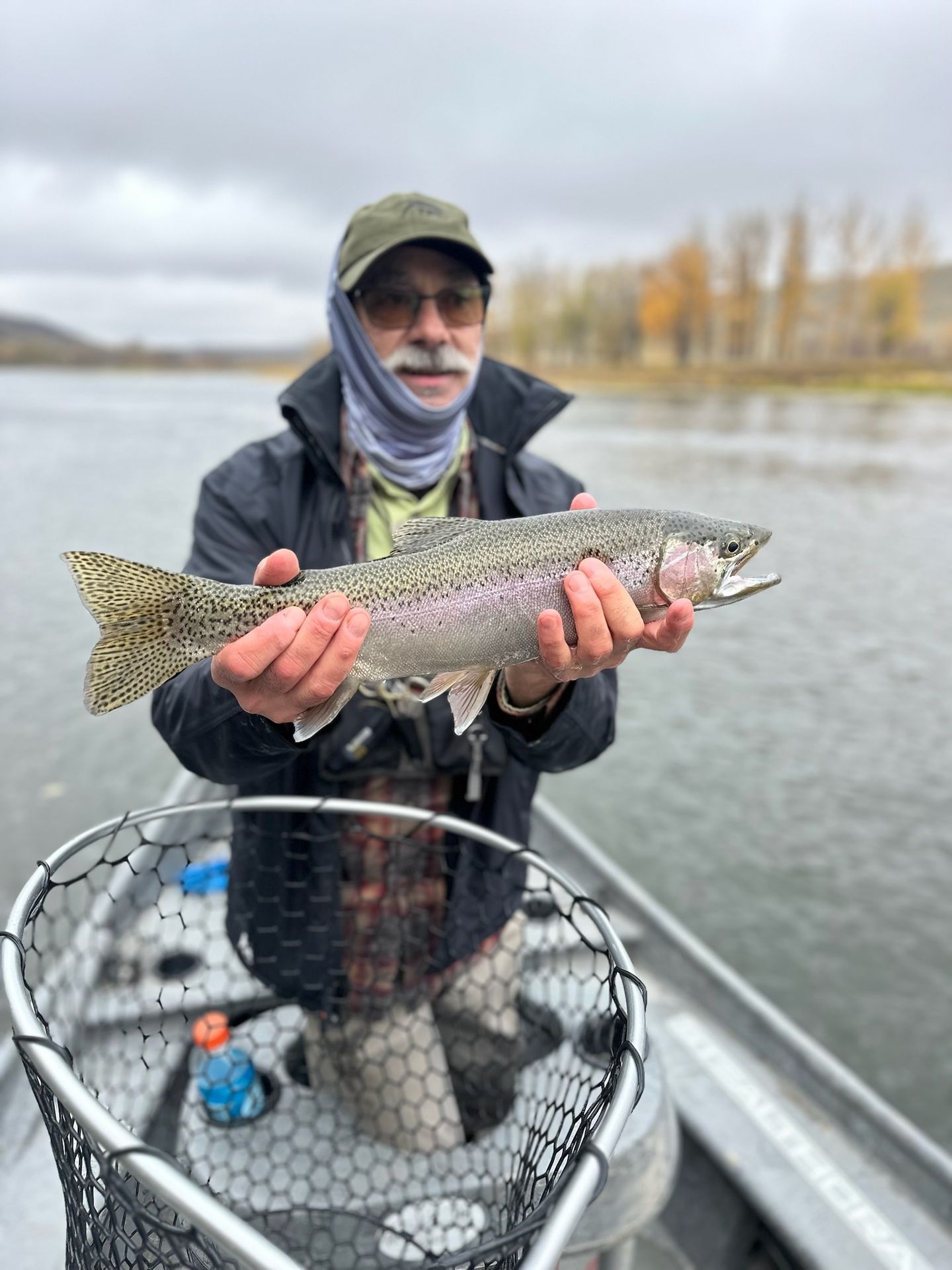Introduction
Winter fly fishing is often overlooked, even though cold months present unique opportunities and challenges that reward the prepared angler. At River People Guides, we believe that understanding fish behavior in cold water, adapting gear and presentation, and planning smartly will put you on the water with confidence—even when ice and snow are in the forecast.
In this post, we’ll cover:
- What changes in fish behavior in winter
- Choosing water & reading winter runs
- Gear, lines, and clothing for cold-weather success
- Fly selection and presentation tips
- Timing, safety, and planning your winter outings
Let’s dive in.
1. Understanding Fish Behavior in Cold Water
Metabolism slows; fish conserve energy
In cold water, fish metabolism drops significantly. They become more lethargic, less likely to chase, and more selective in feeding.
Because of this, your tactics must be more precise, subtle, and deliberate.
Holding zones: where trout “sit tight”
Trout will usually gather in deep, slow, or transition water where current is gentle, as these zones require less energy to maintain position. Reading Water 101
Look for:
- Deep tailouts
- Pools and slack “dead water” margins
- Transition zones (between shallow and deep)
- Areas downstream of structure (rocks, logs) that create calmer eddies
- Tailwaters or spring creeks, where water temps are more stabilized through the winter.
Bite windows tighten
Because of cold, trout may only be active during narrow “bite windows” when water and air temperatures peak (often late morning to early afternoon).
On tailwaters or spring-fed systems, fluctuations are smaller, so these windows may be longer or more forgiving.
2. Choosing Water & Reading Winter Runs
Favor stable systems
Tailwaters (below dams) and spring creeks tend to maintain more constant water temperature, flow, and clarity during winter. These systems often support consistent winter fishing. Fly Fishing Masterclass
Focus on structure & subtle breaks
In winter, structure is your friend. Rather than chasing fast water, target:
- Structure edges (rocks, root wads, submerged logs)
- Margins of deep cuts
- Inside of bends
- Behind large obstructions that slow water
Work transitions carefully. Fish often lie just off the fast current in quieter pockets.
Look for thermal refuges
Slightly warmer water—fed by springs, groundwater inputs, or shallower sun-warmed edges—can concentrate fish. Use temperature breaks as clues to fish location.
Water clarity & stability
Winter often brings low flows and high clarity, so line visibility matters. Avoid high flows or spikes in water that may displace fish or collapse holding lies.
3. Gear, Lines & Clothing for Cold Conditions
Dress smart: layering and insulation
- Base layer: moisture-wicking (merino wool or synthetics)
- Mid layer: fleece, synthetic insulation
- Outer shell: waterproof, windproof jacket
- Avoid cotton, which retains moisture.
- Keep extremities warm: wool or synthetic socks, insulated gloves (fingerless or convertible), warm hat
Waders, boots, traction
- Use breathable, insulated waders (or add fleece underlayers)
- Thick socks (wool blends)
- Boots with good insulation
- Studded soles or microspikes for traction on slippery or icy rocks
Visi Our Online Shop: Wading Gear
Lines, leaders, and tippets
- Cold temps stiffen fly lines—choose a fly line rated for cold or a “winter line” that remains supple
- Use long, fine leaders (10–12 ft) and light tippets (6X, 7X) because trout are more cautious and line presentation must be subtle Understanding Leaders & Tippets
- Use tungsten beads, micro-split shot, or weighted flies to get your presentation down into strike zones
Indicators, rigs & rigs adjustments
- Use small, low-profile strike indicators
- Dropper rigs or two-fly rigs help present multiple options
- A “drop shot” rig (split shot low, flies above) can slow your presentation and keep flies in the zone longer
- Tight-line nymphing is often very effective in winter, for more direct feel and minimal drag
4. Fly Selection & Presentation Strategies
Nymphs dominate
Winter is primarily a subsurface game. Fish are more likely to take nymphs and drifting insects than rises. Nymphs
Top winter nymph strategies:
- Use small sizes (e.g. #18–22) for midges; slightly larger (14–16) for stoneflies if active Fly Fishing With Nymphs
- Fuse attractor + “search fly” combinations
- Micro-weight or use tungsten beads to get flies deep
- Dead drifts and slow presentation are key
Occasional dries & emergers
On calm, slow days when you see rises, small midges or olive mayfly emergers may be in the mix. What Is Dry Fly Fishing
Carry a dry fly rig (12–15 ft, 6X–7X) and small midge dries / emergers for opportunistic surface action. Dry Flies
Streamers & “big meal” tactics
Though less common, large trout may take streamers when conditions permit. But in winter:
- Use slow, subtle retrieves
- Present deep, letting the fly sink before working it
- Use small jig-style streamer approaches in deeper water
- Treat the streamer more like a nymph in many cases
- Don’t overwork the fly—small movements are more effective in frigid water Bull Trout Flies For Alberta
Matching the hatch & adaptability
- Midges are often the baseline food source—carry a variety of midge larva, pupa, emerger patterns How to Match the Hatch in Fly Fishing
- Also include small stonefly or worm patterns in case fish are keying in on those
- Be ready to switch frequently—if one drift or pattern doesn’t work after a few casts, try a variant
5. Timing, Safety & Planning
Pick your times wisely
- Generally, fish mid-late morning through early afternoon when temperatures rise slightly
- Sleep in — early mornings are often too cold, and trout may not be active
- Favor days following milder weather rather than deep cold snaps
Safety is paramount
- Avoid deep or fast water—cold water shock and hypothermia risk increase in winter
- Wear a wading staff, life jacket, and always fish with a partner if possible
- Let someone know your route / plans
- Carry safety essentials: first aid, extra layers, means to start a fire or warm up, headlamp
- Beware of ice: never assume ice over flowing water is safe
Local knowledge & flexibility
- Know your water and its winter behavior
- Be ready to change holes, tactics, or flies as conditions shift
- Use upstream water and temperature gauges to anticipate flow and fish behavior
Visit Our Shop: Stop by Bragg Creek Fly Shop at 7 Balsam Avenue, Bragg Creek, AB.
Contact Us: Have questions? Reach out to us directly!
Conclusion
Winter fly fishing is a different beast, but for those willing to adjust and strategize, it can be deeply rewarding. The challenges—cold, picky fish, subtle presentations—are exactly what separate a thoughtful angler from a casual one. At River People Guides, we encourage anglers to embrace the winter season rather than retreat from it.
If you’d like a guide trip, winter-specific instruction, or local intel on your stretch of water, we’d love to help. Let us help you make your cold-weather angling as effective—and as enjoyable—as possible.
Tight lines and stay warm out there!

